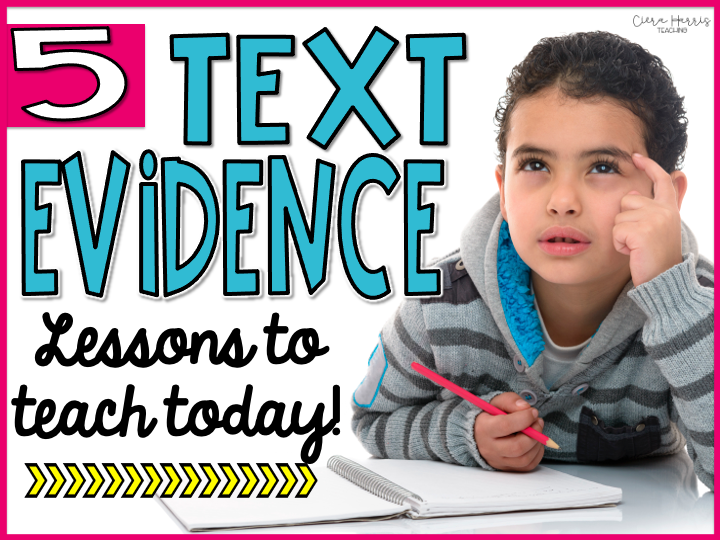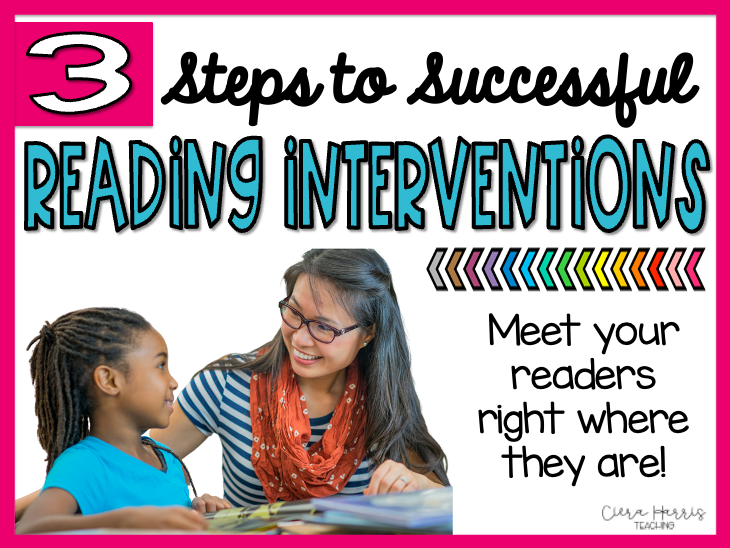Ok, let’s take our heads off from hitting the walls long enough to listen. I know teaching text evidence is hard. Been there, felt that! It doesn’t have to be that way! Many teachers jump right into expecting students to find evidence but don’t break it down and teach this concept to students. Text evidence is just like any other skill. It needs to be explicitly taught so students understand the why behind it. I’m here to share some awesome lesson ideas that you can use right away in your classroom to help focus on and teach the important skill of identifying text evidence.

Want to watch the video instead? Check it out below! Make sure to subscribe to get updates on all new content!
Text Evidence Lesson #1:
 One important concept students need to understand when working with text evidence is that text evidence comes from the text. Yes, that seems simple. But when a student reads, their minds become jumbled with words from the text plus thoughts from their own minds. So when they answer and provide ‘evidence’, they think that what they are providing must have come from the text. They don’t see that there’s a difference between their own thoughts (inferences, going beyond the text) and actual word for word proof in the story.
One important concept students need to understand when working with text evidence is that text evidence comes from the text. Yes, that seems simple. But when a student reads, their minds become jumbled with words from the text plus thoughts from their own minds. So when they answer and provide ‘evidence’, they think that what they are providing must have come from the text. They don’t see that there’s a difference between their own thoughts (inferences, going beyond the text) and actual word for word proof in the story.
One quick mini-lesson I love to do with students is to have them read a text and keep track of their own thinking. I first model this and use a T-Chart with the labels of ‘from the text’ and ‘my own thoughts’. As I read, and a thought comes to mind, I stop and write out the piece of text I just read along with the thought I had. After finishing the text and chart, the students and I discuss the findings. We talk about which side of the chart would be considered the evidence and which would be considered supporting details or thoughts. We talk about how and why both are important but when it comes to absolute proof, which is necessary. This is a great starting point for teaching text evidence because it helps to define true text evidence for students.
Lesson #2:
Have you ever thought about reversing the evidence and question process to help students understand evidence a little better? Here’s how it works! Begin by finding a grade level  (or student level) appropriate passage. Read through it prior to the lesson and find about 5-6 different pieces of strong text evidence that you would like to discuss with the students. These could be important inferences made, events in the story, character actions, etc. Highlight each of those events in the story. Again, you will want to do all of this prior to starting the lesson.
(or student level) appropriate passage. Read through it prior to the lesson and find about 5-6 different pieces of strong text evidence that you would like to discuss with the students. These could be important inferences made, events in the story, character actions, etc. Highlight each of those events in the story. Again, you will want to do all of this prior to starting the lesson.
Then, when the lesson starts, read the text together. After reading, find the first highlighted section of the text and reread it. Discuss what is happening here in the story. Why is it relevant or important? See if the students can create a text-dependent question that the highlighted piece of text could be used as text evidence. This would need to be modeled first so the students can get a strong idea of what you’re looking for in a question. By reversing the text evidence process, you’re allowing students to see how the questions and answers are connected. Students get a stronger idea of keywords in the question, what strong evidence looks like, and much more!
Text Evidence Lesson #3:
Another important concept for students to understand when working with text evidence is true supporting evidence. I don’t know how many times I have worked with students who go back into the text (yay!) and find evidence, only for the evidence not to be the correct evidence! Just because students find the evidence doesn’t mean it’s the right piece of evidence. Again, this makes another perfect mini-lesson for students to experience to help them fully understand your expectations of using text evidence in reading.
Before beginning the lesson, you’ll want to find a piece of text to use (picture book or passage will do!) Read the text yourself and come up with 5-6 text-dependent questions you want your class to practice answering. Then for each question write out an index card with correct evidence that answers the question and a card with incorrect evidence. When you’re ready for your lesson, simply read the text together, go through each question and then sort the index cards to prove which pieces of text evidence DO support the answers and questions and which do NOT. Have a strong conversation about how not all evidence is correct evidence.
Want to snag these print & go pages to practice some of these awesome text evidence activities? Just enter your home email address and name below and they are all yours!
Lesson #4:
This is another great lesson ideas for introducing text evidence or working with students who struggle with evidence. What’s the secret ingredient here? Photos! Yes, using photographs can actually help students with the process of learning how and what evidence actually is. Simply find some unique photographs online (Google is a great place to start looking) and create some photo dependent questions for each photo, just as you would with a piece of text. Practice having students answer the questions and using the photos to prove their answers.
To take this lesson a step further and to make it more concrete as in relation to a text and actual text evidence – after having the students use the photograph, have the students practice writing out their answer using what they would believe the ‘text’ would say in the story as their answer.
Text Evidence Lesson #5:
 This lesson’s focus is more on the writing portion of identifying and using text evidence. Using text evidence in answers requires students to be diligent and thorough with their writing. And with writing not being a strength for many students, this then creates doubt in what they should be writing. I highly suggest using an acronym such as RACE, ACE, or SLAMS to help students craft a strong text evidence response when writing out answers to comprehension questions. RACE stands for Restate the question, Answer the question completely, Cite the evidence, and explain the evidence. ACE is simply a shorter version of RACE. SLAMS stands for complete Sentences, Lines (use most of the lines), Answer the question and all of its parts, Mechanics, Support with text evidence.
This lesson’s focus is more on the writing portion of identifying and using text evidence. Using text evidence in answers requires students to be diligent and thorough with their writing. And with writing not being a strength for many students, this then creates doubt in what they should be writing. I highly suggest using an acronym such as RACE, ACE, or SLAMS to help students craft a strong text evidence response when writing out answers to comprehension questions. RACE stands for Restate the question, Answer the question completely, Cite the evidence, and explain the evidence. ACE is simply a shorter version of RACE. SLAMS stands for complete Sentences, Lines (use most of the lines), Answer the question and all of its parts, Mechanics, Support with text evidence.
Once you have picked an acronym to use, here’s a simple and meaningful mini-lesson you can try! It’s called ‘What am I missing?’ Before beginning, find a text to use and read it. Create 4-5 text-dependent questions and write out your answer to them using your strategy. However, when you write the answers, leave one of the letters OUT of your answer. For the lesson, have the students read the text and then read the questions and answers you provide. Have the students analyze your answers for each of the letters in the acronym and figure out what is missing and can they fix it? This helps them understand your expectations when it comes to writing out their answers to text-dependent questions!
I hope you found these text evidence lesson ideas useful! Make sure to hop back up and grab your FREE evidence lesson pages to help get you started! Feel free to pin the image below to save this post for later!







